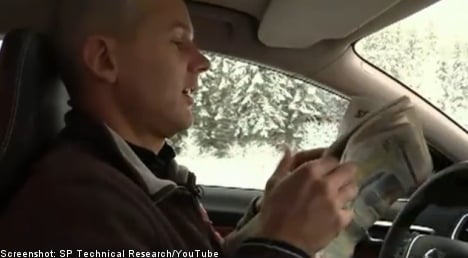Have you ever thought how nice it would be during those long motorway drives through Sweden if you could take your hands off the wheel, put your feet up, perhaps watch some TV, or surf the web?
As it turns out, the day when “driving” without keeping your eyes on the road may be possible sooner than previously thought thanks in part to Swedish carmaker Volvo’s involvement in a road train project currently under development.
Volvo is one of the members of an EU funded project called SARTRE (Safe Road Trains for the Environment) which is pioneering a driver-free project known as a road train.
In essence, the concept involves putting your car on autopilot and joining the so-called trains, controlled by a lead vehicle.
Besides Volvo Car Corporation and Volvo Technology, the SP Technical Research Institute of Sweden is also involved with SARTRE, which is led by engineering company Ricardo UK Ltd.
Other major players include Idiada and Robotiker-Tecnalia of Spain, as well as Institut für Kraftfahrwesen Aachen (IKA) of Germany.
Also known as platooning, the scheme involves car drivers using a GPS to find out if a road train is near, while radar can determine the vehicles’ following distance to each other. Electronic throttles and power steering units would allow the lead vehicle to control each car in the train.
The idea is predicated on the assumption that, if you know you are going to drive on a long motorway stretch, you can even “book” your place in the convoy in advance, or detect a signal whilst on the move and “hop on”.
Once you are “locked in” by the computerized signal, the controls of your car are detected and directed by the lead vehicle. After that you can do what you like until you are ready to leave the convoy. At this stage the gap between you and the other cars is slowly widened so you can safely exit and continue your journey hands-on.
Trials have already been carried out near Gothenburg, where a Volvo S60 followed a lead truck around the carmaker’s test facility, while other pilot projects are due to take place soon in Spain and the UK.
The success of the scheme relies heavily on the lead vehicle. This will be fitted out with the necessary safety equipment to control the other vehicles and driven by a specially trained professional.
“We were very pleased with the success of the first real test, not least because it was the first time that all the various partners in the project had come together at the same time,” says Erik Coelingh, an engineering specialist at Volvo Cars.
“Braking, accelerating, the camera system and all the key aspects worked without any problems.”
The road train system is designed to improve a number of things, Coelingh explains.
Firstly, the system is meant to improve road safety by reducing the likelihood of human error, whicgh accounts for at least 80 percent of road accidents.
Secondly, road trains will also reduce fuel consumption and thus CO2 emissions by up to 20 percent.
In addition, the system is also expected to relieve traffic congestion by using roadway space more efficiently.
Vehicles are expected to travel at motorway speeds, but with only a few metres separating each car, which is a key reason why the EU is so interested in the project.
“Platooning” as part of a road train is also convenient for the driver because it frees up time for other activities, what Coelingh refers to as “driver freedom”.
“It is great to have the possibility to do other things and really relax, whether that means reading a newspaper or checking the computer or something else,” he explains.
“Those of us who drive actually enjoy it most of the time, but the same daily journey to and from work, for instance, can get tedious, so platooning would really be a bonus at a time like that.”
The next step will be carrying out more extensive trials using more vehicles, which could happen after the summer of 2012.
Then, if successful, there will several years of testing, improving the technical aspects and not least navigating what promises to be a highly complex legal process to clear the project across so many countries.
As a result, it is unlikely that we will see a road train in action on our motorways for at least another ten years.
Nevertheless, Coelingh remains bullish about what he sees as the enormous potential of platooning. Although he admits that improving road safety isn’t the only reason he’s involved with road trains.
“Above all, it is a really fun project to be involved with” he concludes.



 Please whitelist us to continue reading.
Please whitelist us to continue reading.
Member comments